In just under a week’s time I should be on my way to Iceland for a return visit. My first visit was a very long time ago, back in August 2004. I know that since then things have changed, not just in terms of DT (mostly on the volcanic front), but also in general tourist numbers overall, while prices remain painfully high. That’s partially why this upcoming trip will be for only ten days.
The main points of my (dark) interest will be a couple of new lava/volcano shows/exhibitions on the mainland and in the capital Reykjavik, but most importantly the offshore island of Heimaey, where a new “Pompeii of the North” has been developed since my previous visit. This involves some unearthed house ruins from the destruction the new volcano Eldfell caused 50 years ago in 1973.
But I admit that other than a few DT-sites that I should visit, this trip will be about a good dose of escapism as well. I’m really in need of that after a very difficult year so far, healthwise. I hope that the clear air, wide vistas and grand scenery of beautiful Iceland will offer some respite and lifting up of the mind.
I’m also looking forward to the culinary side of being in that country. And in the case of Iceland that even involves dark aspects too! (Cf. the older post DT and food!) In particular: it’s one of the very, very few countries where you can quite regularly find whale meat on restaurant menus. Indeed, they still eat whale in Iceland, and hunt whales for their meat (as they do in the Faroe Islands, Japan and to a lesser degree Norway). I admit I did once have a bit of it on my last trip in 2004 – though I hadn’t ordered it, I hasten to add! It came as a “greeting from the kitchen” at a posh hotel restaurant in Buđir. My wife was appalled and refused to touch it. But I thought, now it’s here, and rather than return it (and potentially offend the waiter and/or chef), I just had it … It was raw and marinated (the marine meat equivalent of sushi, if you will) and quite meaty, but tastewise OK I would say (even though normally I eat next to no meat). Another idiosyncratic Icelandic speciality on the meat front is seabirds, including the cute puffins! And on the fishy side “acquired-taste” items include bone-dried cod (very nice with butter, but indeed chewy) and the infamous ‘Hakarl’, which is fermented pieces of Greenland shark. ‘Hakarl’ has a well-deserved reputation of being perhaps the most foul-smelling food item in the world (think along the lines of a decrepit pub toilet that hasn’t been cleaned in over a year). Back in 2004 at a traditional Icelandic restaurant in Reykjavik I did have one single piece of the stuff that came as part of a starter platter. It was a real challenge to get it past the nose, though taste-wise it was far less remarkable. Nonetheless, I have no intention of repeating the experience ever again, not one single second piece …
But back to the visual. I thought that before I set off on this new trip to beautiful Iceland I’d give you a combined photo essay of some of the dark bits I saw back then, plus a few extras of the not so dark sides as well. Please note that I shot these photos with my first ever digital camera (which sported a whopping 2.4MP sensor 😉 ). They may be halfway OK in this small format here, but in full resolution you cannot fail to see just how much digital photography equipment has progressed since then. But never mind. Here we go – photo gallery roll!
To begin with, here’s one that nicely exemplifies why Iceland is often referred to as the “Land of Ice and Fire”. This was taken from a small plane on a scenic flight and it shows Kverkfjöll, where a volcanic geothermal hotspot meets the country’s largest glacier, Vatnajökull:
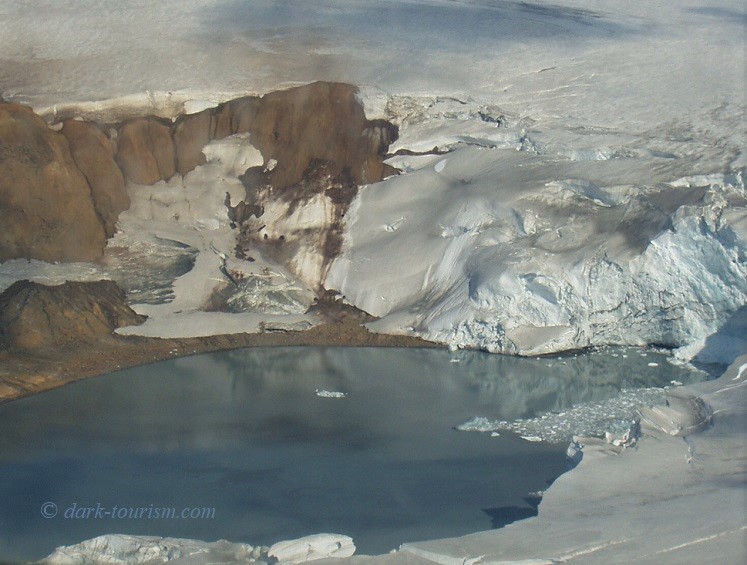
And it is Iceland’s volcanism that gives it its principal dark sites. One of the two so far covered on my website is Heimaey, part of the Westman Islands (Vestmannaeyjar in Icelandic), where in January 1973 a new volcano fissure suddenly opened spewing lava and ash. This covered a good part of the island’s only town/village (also called Heimaey). In 2004 on a scenic drive round the island I saw these remnants of a house that was crushed by the 1973 lava flow:
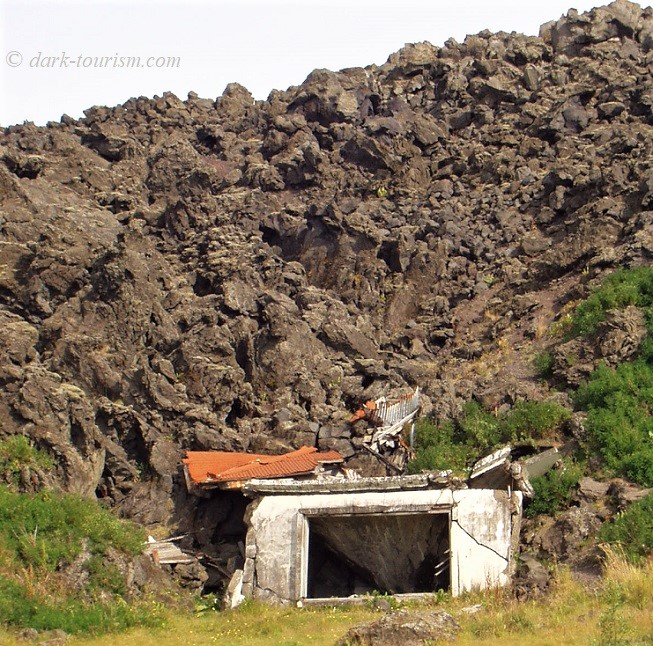
Volcanic activity also made for this extraordinary sight: the explosion crater in the interior of Iceland called ‘Viti’ (which means “hell” in Icelandic!):
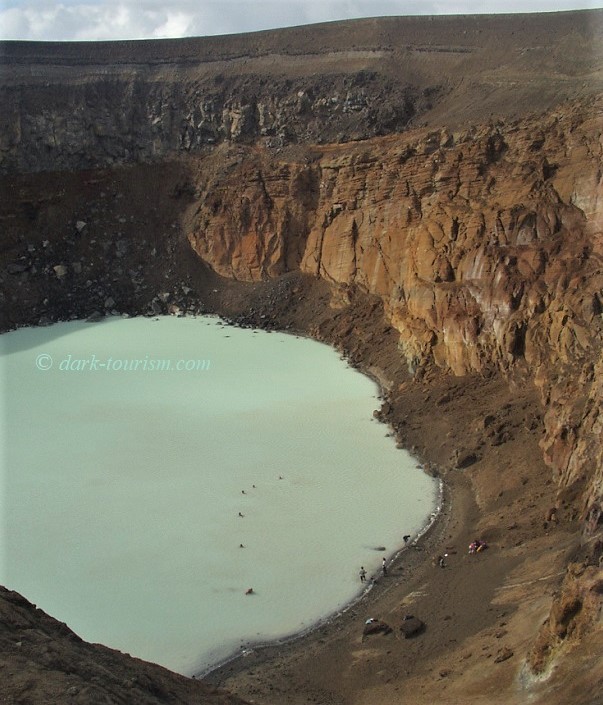
The bottom of this crater is filled with mineral-rich greenish water which is heated by ongoing geothermal activity to a balmy 25 degrees centigrade. Hence visitors to this exceptional site often scramble down the steep sides of the crater to go for a dip in these waters: in this photo spot the little dots in the water and on the shore – those are tourists.
You are advised to go in naked, because any swimwear you might go in with would forever stink of sulphur (think rotten eggs). My wife and I partook in this incomparable activity, did go in naked, but the towels we used to dry ourselves off afterwards so stank of sulphur that we left them in the boot of the car for the remainder of the trip. And back home it took several washes to get the stink out.
And here’s another photo from this site. This time Viti is just about visible at the bottom right; the larger body of water in the background is Öskjuvatn (same image as the featured photo at the top of this post):
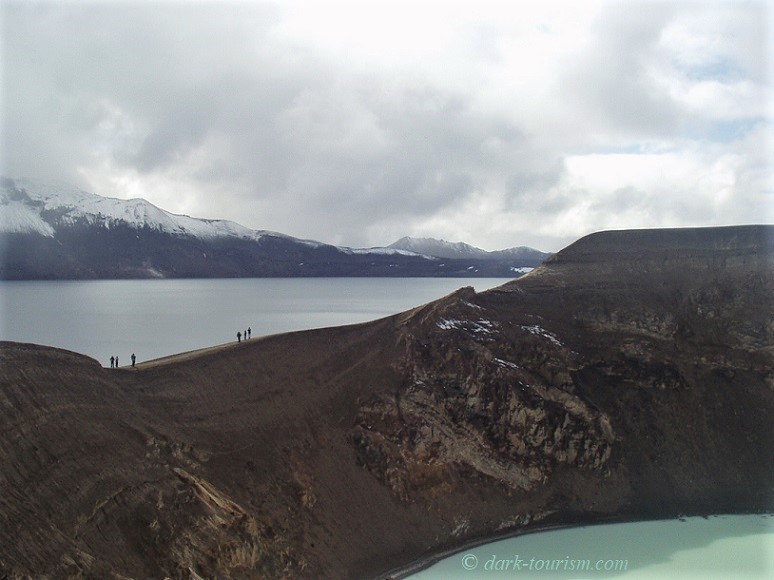
Öskjavatn is one of Iceland’s largest and deepest lakes, and like Viti it was created in 1875 in a gigantic eruption of the Askja caldera that both are located in. Today, the waters of Öskjuvatn are icy cold, but still some people brave swimming in these too. There is a dark aspect beyond volcanism here as well: in 1907 two German researchers who had taken a boat out on to the lake disappeared. No trace of them has ever been found!
Askja is still a somewhat dicey destination, and getting there requires high clearance vehicles for the rough terrain and for fording several rivers en route. The safest and easiest way to get there is to join a group tour in a specially adapted AWD “bus” with extra-high clearance, which is what my wife and I opted for.
The interior of Iceland is completely uninhabited, and it can be reached only in summer. There are two routes traversing the interior, one is demanding and should only be attempted by experienced 4WD-vehicle drivers and in a convoy of at least two cars (so that if one gets stuck the other can pull it out). The other route is less difficult and could even be done by a normal 2WD vehicle, though a jeep/4WD SUV is better. About halfway between the southern and northern end of this route is a geothermal field called Hveravellir. Here’s a photo from there:
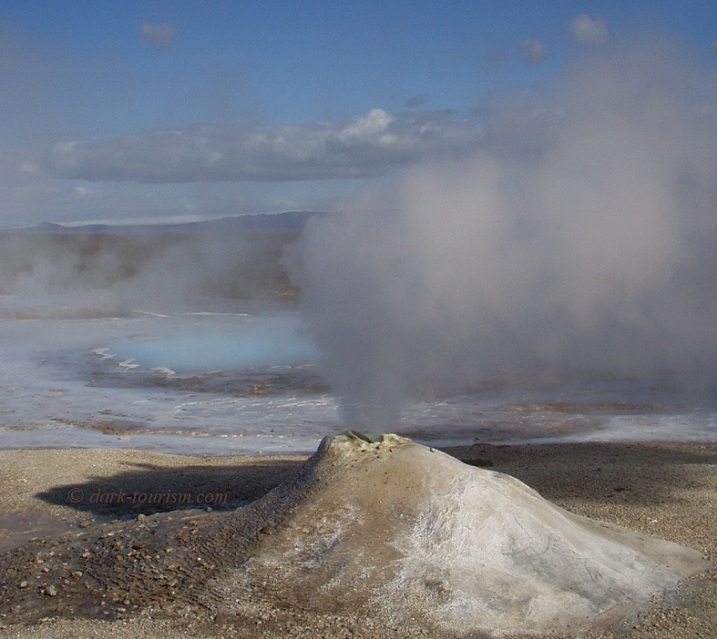
The steam blown out of this mini-crater was hissing like a bad-tempered dragon. And of course you shouldn’t put your hand in the steam flow (it would instantly evaporate with the steam presumably).
Not all geothermal fields in Iceland (and there are plenty) are quite so angry. This one at Hverarönd also features some quietly bubbling mud pools (in addition to boiling ones and yet more dynamic steam vents):
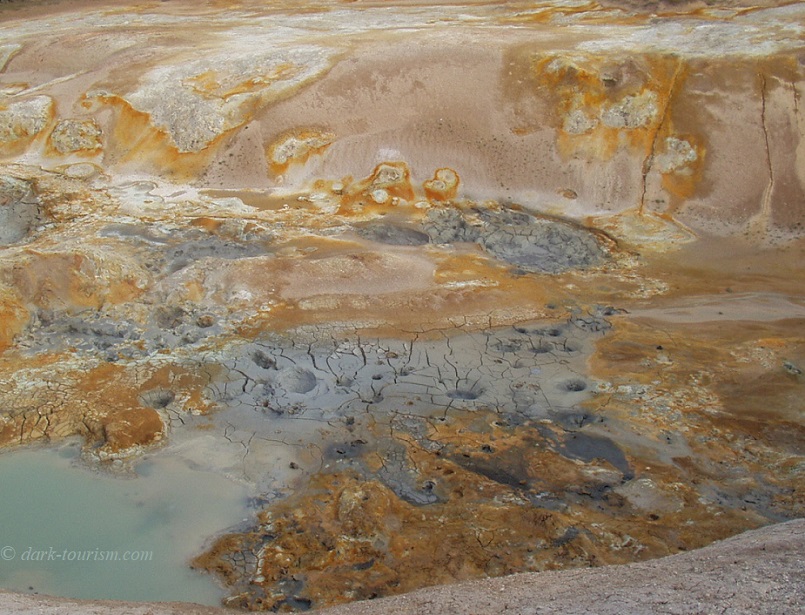
Amongst the ubiquitous remnants of past volcanic events you can find in Iceland are many an old lava field. One of the most fabled ones is at Dimmuborgir in the Myvatn area of northern Iceland. Amongst other things I found there was this lava stack that looks a bit like a grim Viking warrior:
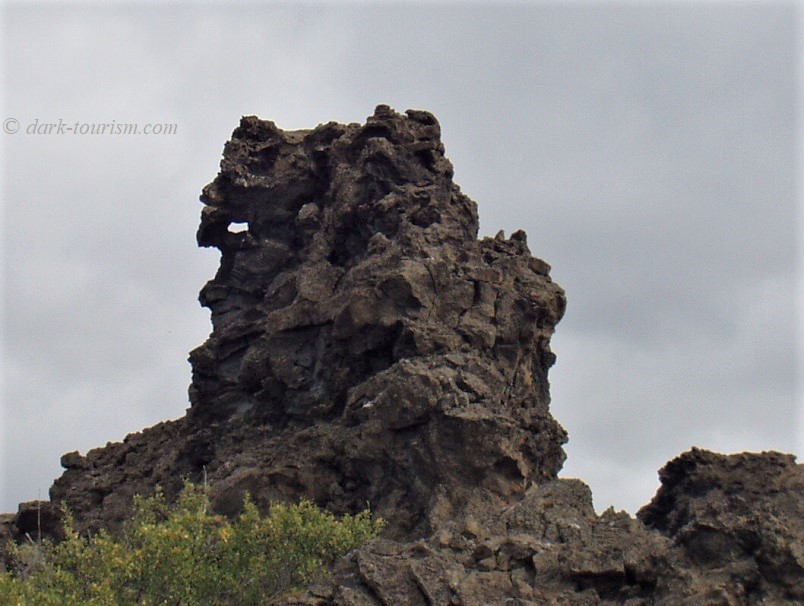
Looking at this you may think “no wonder so many Icelanders believe in trolls and elves”. Even Christianity locally adapted this place as one associated with Satan. Dummuborgir by the way means “dark castles” in Icelandic and it inspired a certain Norwegian symphonic black metal band to name themselves after it (though they spell it as two words: Dimmu Borgir). So again a good dash of dark here.
In addition to such more metaphysically dark aspects, there are also quite literal dark ones, such as this black tuff ring crater called Hverfjall:

If you think this looks a bit like a crater on the Moon, then you’re not the first one. In fact in 1968 NASA used this place for training the Apollo astronauts who would then go on to land on the real Moon!
Other places on Iceland also have a distinct moonscape character to them, such as this stretch of barren interior desert on the Kjölur Route:

Of course, the moonscape illusion only holds as long as you ignore the blue (or grey) sky and there are none of the glaciers visible which flank this route (Langjökull to the west, Hofsjökull to the east), as seen in this next photo:

The glaciers themselves are also a key attraction of Iceland. This includes the largest icecap in the northern hemisphere outside of Greenland (for the time being at least). This is the aforementioned Vatnajökull. And when I was in Iceland in 2004 I took a scenic flight that included flying over a part of this sea of ice:
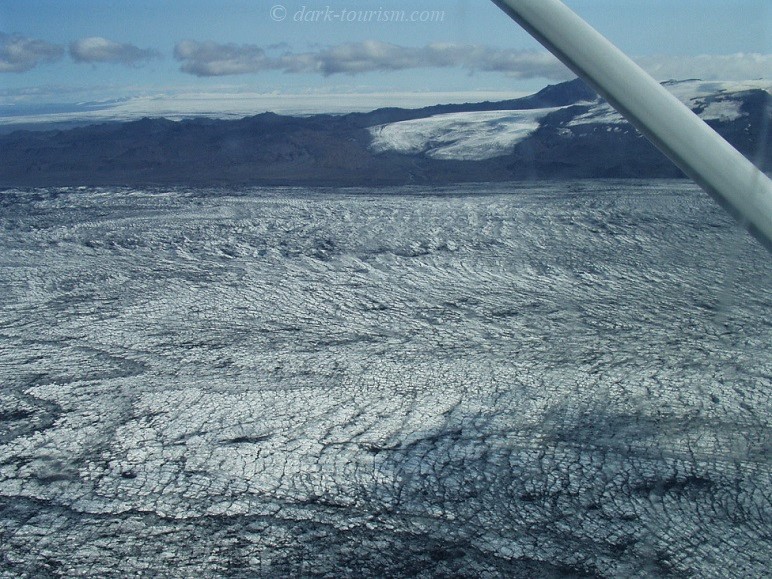
You can actually go on the glacier itself by means of so-called ‘super jeeps’ (with enormously big and wide soft tyres) and also go snowmobiling. I did this on Vatnajökull, where I took this photo during a break:
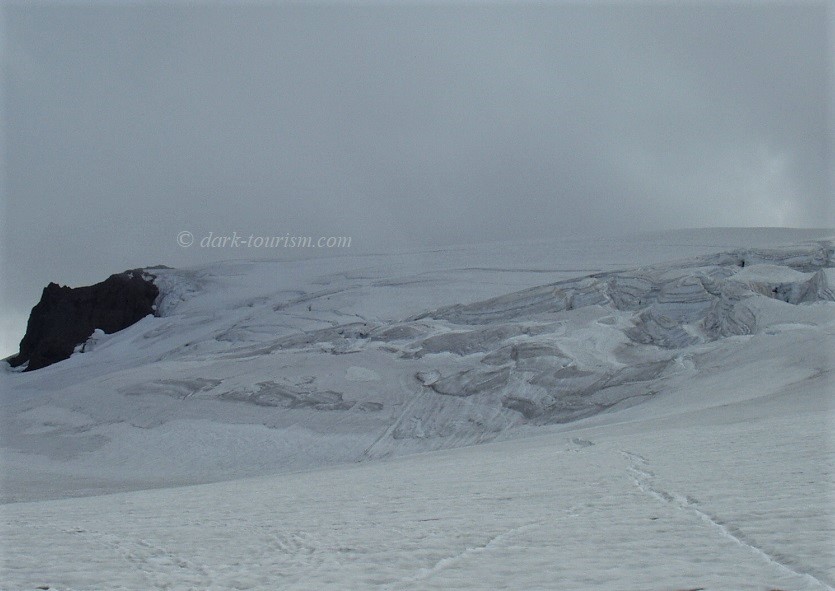
This glacier, moreover, has given Iceland one of the most enchanted, hence most popular (and much more accessible) star attractions, called Jökullsarlon (‘glacier lagoon’), which you can explore by a specially adapted amphibious vessel. From this I took the following picture:
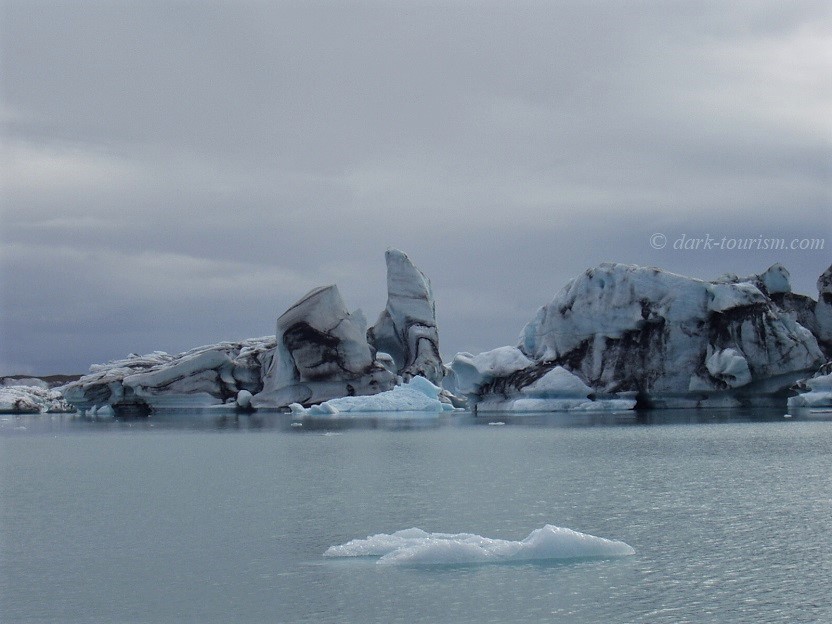
One of the greatest joys of travelling around Iceland, though, remains driving your own (hire) vehicle. Roads are good and the No. 1 road goes in a circle all around the island (except for the West Fjords). Proper off-road driving is not allowed (to protect the delicate ecosystem), but there are quasi-off-road routes along gravel tracks through otherwise inaccessible remote parts of Iceland’s splendid scenery. Apart from those two routes through the uninhabited interior (see above) this includes a route through the incredible Landmanalaugur. This, too, is only suitable for 4WD vehicles, and you frequently have to ford rivers. This can be tricky and dangerous if weather conditions are not good. Hence the warning signs like this:

A unique geological feature of Iceland is a “canyon” at the rift between the American tectonic plate and the European counterpart at Thingvellir. And as the next photo proves it’s a place very popular with tourists:
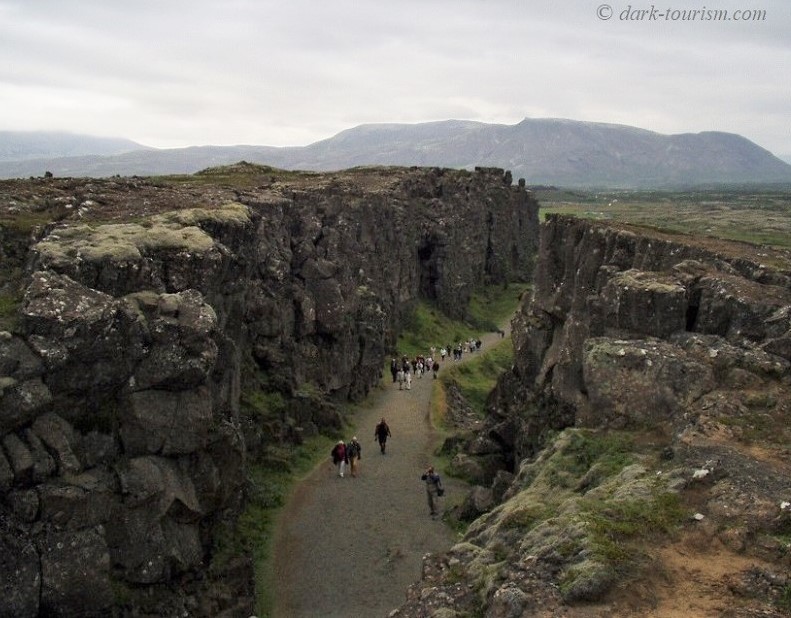
Other popular spots are many of Iceland’s grand waterfalls. Not the biggest, but considered by many the most impressive, is this two-tier fall called Gullfoss:
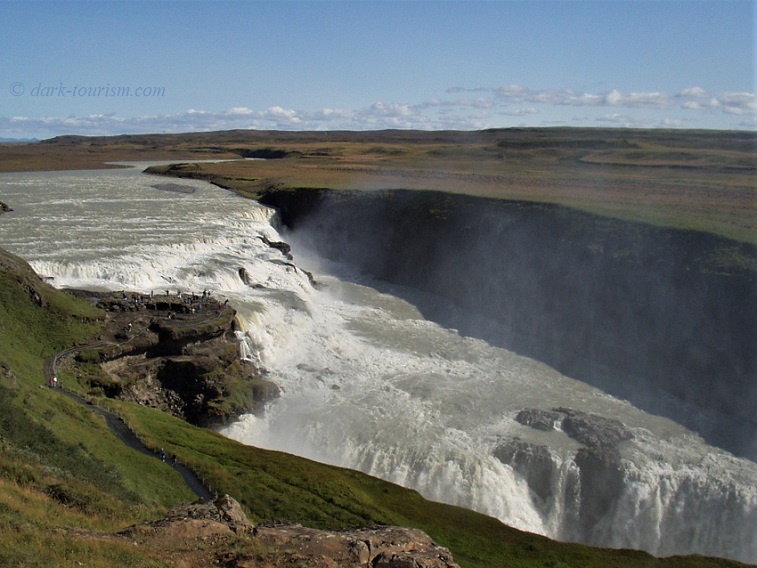
A popular offshore watery tourist activity is getting a boat for the purpose of whale watching. I did this too, even on two separate such excursions, one from Husavik in the north (which was unsuccessful) and another from Olafsvik on the Snaefellsnes peninsula in the south-west. And on that sailing we did spot two humpback whales. Here’s one in the distance doing “the fluke”:
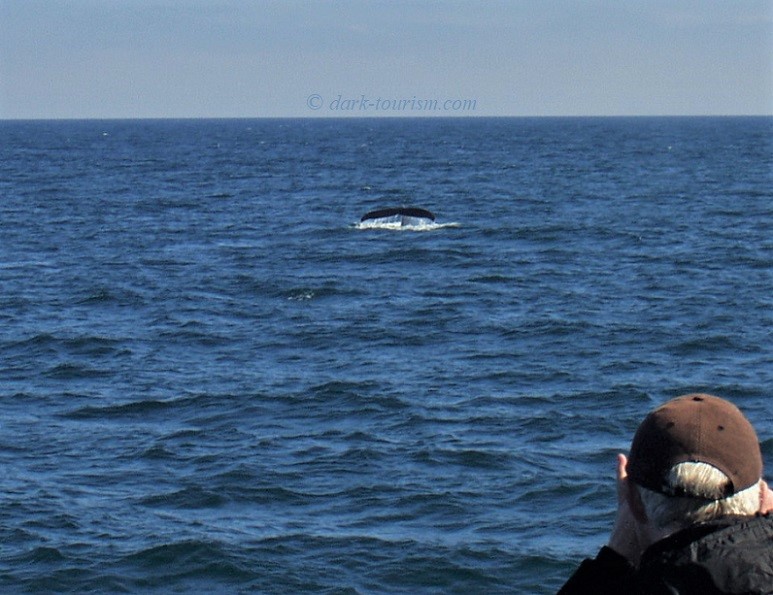
Later we were lucky enough that one of the whales came very close alongside the boat we were on (you can see even the white of the submerged right fore-fin!):
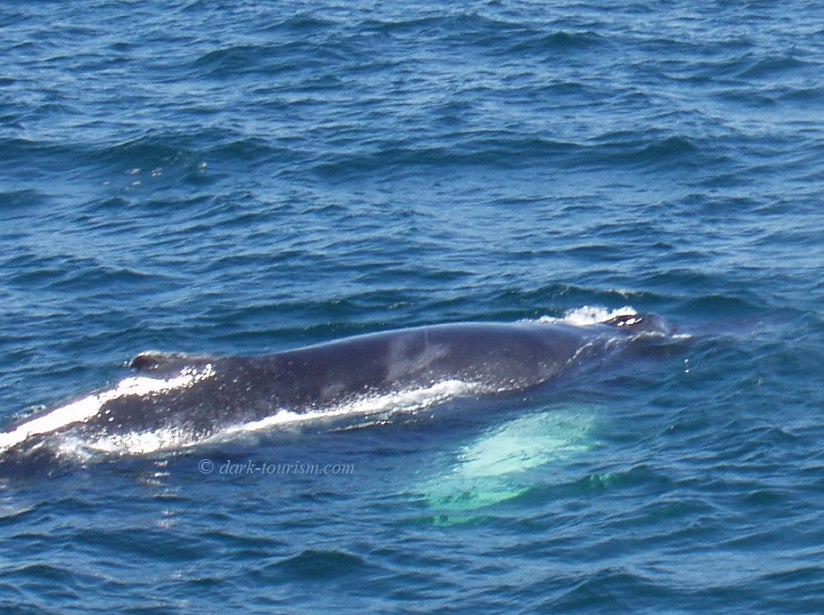
Finally, Iceland is not just about grand scenery, volcanos, glaciers, whales, etc., its capital city Reykjavik also has its charms. Here’s a photo from the street ending at the iconic Hallgrimskirkja church, whose outer facade is modelled on volcanic basalt columns (you just can’t get away from the volcano theme for long in Iceland …):
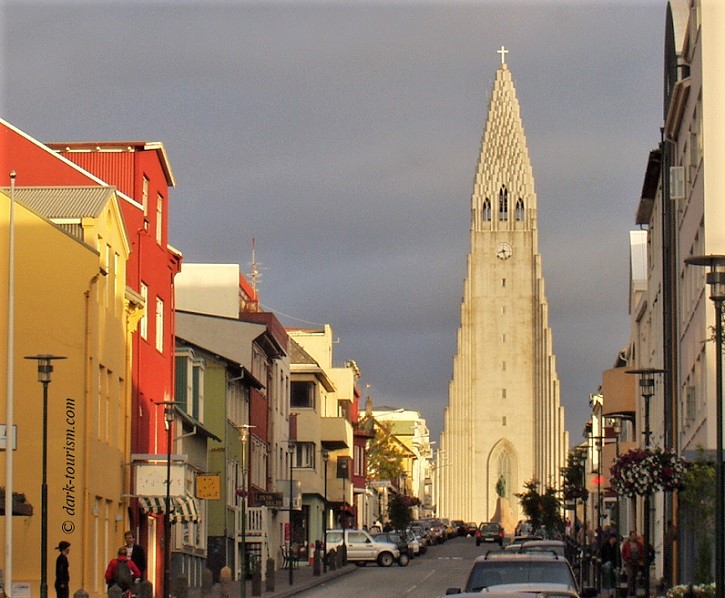
But with that I come to a close. Needless to say I am now very much looking forward to reconnecting with this wonderful country. And chances are that the new photos I will take in Iceland will be of much better quality than those above (although, I won’t see all of the places covered above again this time – no Viti, no snowmobiling or whale watching, for instance).




One Response
What an engaging and thought-provoking post! Dark tourism is such a fascinating topic, and your reflections on Iceland, a place that combines natural beauty with a history rich in dark events, are truly captivating. For those seeking inspiration for their tourism dissertations, I highly recommend checking out this fantastic resource on Tourism Dissertation Topic Ideas. It’s a comprehensive guide that offers a wide array of intriguing topics to explore in the field of tourism studies.